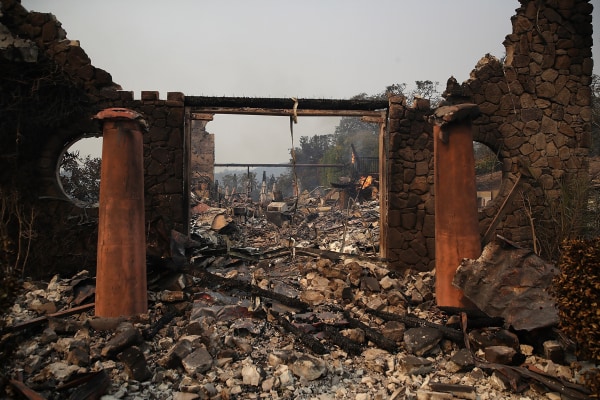Inevitable, Dread Wildfires in California
"We live in the valley, where it's concrete and strip malls and hotels and supermarkets."
"The last thing you think is a forest fire is going to come and wipe us out."
Jeff Okrepkie, Sonoma, California
"Though our containment numbers haven’t gone up just yet, we’ve at least been able to hold these fires and keep them at their current acreage."
"Overnight, the wind that had fanned these fires had really decreased, and that gave us an opportunity to really take a stand against these fires."
"We are again today [Tuesday] hoping to see very little wind compared to Sunday."
"Many of these fires, it’s going to take several more days, even potentially more weeks, before we have full containment."
Cal Fire spokesman Daniel Berlant
Eighty km/h winds drove flames in blazes that began to fire up the California landscape on Sunday, "at explosive rates" according to Ken Pimlott, director of the California Department of Forestry and Fire Protection. Over a 200-mile region north of San Francisco, from Napa to Redding in the north, no fewer than fourteen large wildfires burned through the landscape, leading Governor Brown to declare a state of emergency in Napa, Sonoma and Yuba counties.
If it's October it's wildfire time in California. These fires were so ferocious that authorities had little option but to focus on safely removing people from the affected areas, abandoning their homes to the fire in an area covering over 160 square kilometres, and eight counties. At least seventeen people are now confirmed dead as a result of those wildfires and 1,500 homes burned, destroyed, while high-end resorts, grocery stores and tree-lined neighbourhoods suddenly became incendiary danger zones.
| Smoldering Peters Canyon Regional Park in Orange. (Irfan Khan / Los Angeles Times) |
California is no stranger to wildfires. Already, at this stage in the battle against the fires, authorities are declaring the current crop the worst such that the state has ever experienced. Miles along main gateways into wine country there is an eerie resemblance to a nightmarish blackened inferno with thick smoke rolling from one structure to another, and encompassing some of the famed wineries of the state.
In Santa Rosa, the largest city in the fire area in Sonoma County, the population base is about 175,000. Hotels have burned to the ground, along with homes and grocery stores and any other structures with the misfortune to be in the fire's path, fed by heat and high winds. Businesses and homes alike lighting into blazes shutting down schools, forcing hundreds of patients to evacuate two city hospitals.
At a state home for the severely disabled, emergency workers dashed from their vehicles to take part in the evacuation of residents when flames began licking the side of the sprawling campus in Glen Ellen, Sonoma County. As flames closed within close proximity, the emergency crews succeeded in evacuating hundreds. "It was like Armageddon was on. Every branch of every tree was on fire", Mike Turpen of Glen Ellen described the situation.
 |
| The remains of the fire damaged Signarello Estate winery after a wildfire moved through the area in Napa, California, on Oct. 9, 2017. Justin Sullivan / Getty Images |
"It may take weeks to determine the spark that touched off each of the firestorms that consumed hunks of more than a dozen California communities this week."
"But the consensus in the scientific community is that the conditions that cleared a path for the tsunami of flame were made by humans. Decades of aggressive firefighting left too much fuel on the ground. And more than a century of carbon emissions exacerbated the state’s drought and the record high temperatures that baked brush and timber to an explosive dryness."
NBC News
Labels: California, Environment, Natural Disasters, Nature, Wildfires

<< Home